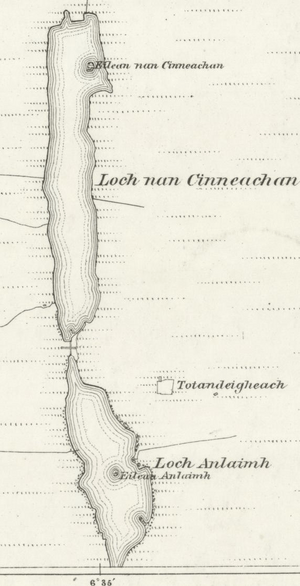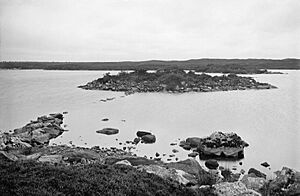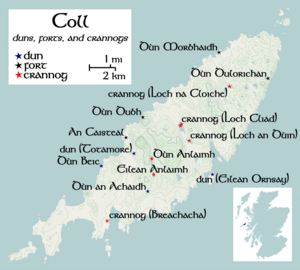Dùn Anlaimh facts for kids
Dùn Anlaimh, also known as Dùn Amhlaidh or Eilean nan Cinneachan, is a special kind of island called a crannog. A crannog is an artificial island, meaning it was built by people, not formed naturally. This one is found in Loch nan Cinneachan, on the island of Coll in the Inner Hebrides of Scotland.
On Dùn Anlaimh, you can still see the remains of old walls and buildings. These ruins look a lot like other old forts found on islands nearby. Experts believe Dùn Anlaimh was built during the late Middle Ages. Local stories on Coll say that a Norse (Viking) chieftain once lived here. He was supposedly defeated in a battle nearby. An early 1900s historian, Erskine Beveridge, thought Dùn Anlaimh was one of the most interesting forts on Coll. The RCAHMS calls it a 'crannog' and an 'island dwelling'.
What is Dùn Anlaimh?

Dùn Anlaimh is an ancient site. It's a crannog, which means it's an island that people built a long time ago. They would often build these islands in lochs (lakes) for protection. The remains on Dùn Anlaimh show that there were once walls and several buildings there. This suggests it was a fortified place, like a small castle or stronghold.
Stories of Anlaimh and the Fort
For many years, people on Coll have told stories about the old forts on the island, including Dùn Anlaimh. These stories were written down in the late 1800s and early 1900s.
One popular story was collected by Rev. John Gregorson Campbell in 1895. It tells of the Laird (a Scottish lord) of Duart, who was going to collect rent on the island of Tiree. He stopped at Coll for food. A woman there told him he wasn't worthy of food because he hadn't taken Coll for himself. She said three brothers from Lochlann (a old name for Norway or Viking lands) controlled Coll. One of them, called Big Annla (Annla Mòr), lived in the fort at Loch Annla (Dùn Anlaimh). The woman said she had thirty men ready to fight.
The Laird of Duart went to Loch Annla fort alone one evening. He was welcomed kindly. Annla's arrows were near the fire. The Laird slowly moved closer to them until he could grab them and escape. This led to a fight at a place called Grimsari. This story might explain why the Laird of Duart encouraged Iain Garbh to take control of Coll.
Historian Erskine Beveridge, in 1903, believed the forts mentioned in this story were Dùn Anlaimh, Dùn Beic, and Dùn Dubh. Iain Garbh was a son of Lachlann Bronnach, a chief of the Macleans of Duart. Iain Garbh is said to be the ancestor of the Macleans who later ruled Coll.
Beveridge also heard another version of the Norsemen story. This version said the events happened in 1384. However, he noted that this date was probably calculated much later. It was based on the idea that the Macleans of Coll had owned their land for exactly 472 years when they sold it in 1854.
Beveridge's version of the story says that the Norse chief who lived in Dùn Anlaimh was named Olaf. He held Coll long after other Norsemen had left nearby islands. MacLean of Duart already owned Tiree, and one of his sons decided to attack Olaf's stronghold. When the Norsemen realized they were losing, they threw their weapons into the loch. They did this so their enemies couldn't use them.
Another similar story was published in 1922 by Rev. Dugald MacEchern. It also tells of Maclean of Duart being told by a woman that he should take Coll from the Norsemen. He then attacked the three brothers from Lochlinn who held the island. The fight happened at Grimsary.
These old stories about Dùn Anlaimh and the defeated Anlaimh have led some modern historians to think that Anlaimh might be an ancestor of the MacAulays of North Uist. This family is traditionally said to have moved to Uist from the Inner Hebrides.




